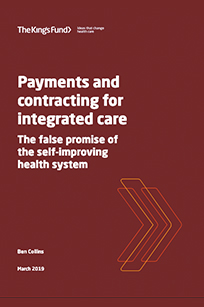Payment models: sharing the risk
NHS payment models – whether based on crude block contracts or more detailed approaches – can often leave one party unfairly out of pocket. Block contracts can leave providers covering the costs of additional activity outside of their control with no additional payment. Activity-based systems could leave commissioners paying full rates for additional activity that only incurs a marginal cost or leave providers unable to cover fixed costs if activity falls short.
Mechanisms to share some of these risks are not new. Caps and collars – perhaps in a crude way – have been used to limit the financial impact when activity or costs go off plan. The marginal rate emergency tariff was a high-profile attempt to balance out some of the risks of under- and overperformance on non-elective activity.

But some of these approaches dampened the incentives created in the primary payment model. And in some cases they were driven by the need to cap spending rather than ensure commissioners paid and providers received a fair amount to cover legitimate costs.
In recent years, attention has turned to developing new payment models in England, recognising that the incentives in the current activity-based payment by results approach do not align with the partnership working needed to deliver system working and more integrated care. Capitation-based systems are widely seen as a better mechanism once integrated care systems (ICSs) are in place, ensuring payment mechanisms don’t get in the way of pathway changes such as moving activity from acute settings to the community.
Formal risk-sharing arrangements are seen as an important component alongside new population-based budgets, and the NHS Improvement and NHS England joint pricing team have worked to support the development of ideas in the former vanguard sites and pioneering ICSs.Into practice
But with all areas – through sustainability and transformation partnerships – now actively pursuing greater system working, the joint pricing team is keen to explain how risk could be shared both with existing contracting arrangements and as new approaches emerge. It has started to do this through an introductory series of webinars, which got under way in February.
‘This is an attempt to give people the tools to share risk more optimally rather than saying this is exactly what works,’ says Chris Skilbeck, head of pricing engagement at NHS Improvement, stressing that there are no plans to mandate any approach.
‘As we move to less episodic ways of doing things, there is a whole range of mechanisms – such as the break glass arrangements in the new blended payment approach for emergency care – that need to be part of the new landscape. These things may be routine in a few years, but we need to break the back of it now and get a few of them in and working.’
He suggests that classic examples of where risk sharing might be appropriate include when systems are looking to transfer activity into the community – or increase community service provision that leads to reduced acute activity. ‘What happens if you reduce the acute activity below a viable level or if the activity left with the acute is more complex?’ he says.
Another example might be where systems are looking to implement the Getting it right first time hub and spoke model, consolidating more complex or less frequently undertaken activity in a single trust. This may ensure the trust undertakes sufficient procedures to maintain quality, but what happens if the length of stay goes up because of the more complex casemix, or if the activity displaces less costly elective activity?
Payment reform is a slow-moving beast. While it aims to change behaviours, it wants to do it in a way that doesn’t fundamentally destabilise health systems. The joint pricing team’s new blended payment for emergency care builds on an approach first proposed by the two bodies five years ago. Their original three-part payment model for urgent and emergency care (UEC) would have had a fixed, core funding element supplemented by further elements for volume and quality. The quality component does not form part of the new blended payment system.
A form of activity risk sharing is built into the blended payment approach, with the big difference between it and the previous marginal rate tariff (apart from the value of the marginal rate used) being a more realistic, locally agreed level of planned activity.
Specific risk sharing mechanisms are seen as assisting the move to integrated care. ‘Together, blended payment and, where appropriate, risk sharing models should help to align financial incentives to support each system’s healthcare goals and strategic aims,’ says Mr Skilbeck.
NHS Improvement’s webinars introduce two types of risk sharing currently being explored. Finance-based risk sharing aims to share the risks of deviations in expected costs and/or revenues, while activity-based risk sharing caters for when activity or utilisation levels are not as expected.
A question of need
Lily Tang, NHS Improvement’s pricing strategy lead, says the first thing to look at with any risk sharing arrangement is whether it is needed. ‘If the primary payment is allocating finance or activity risk to the most suitable organisation(s), it is unlikely a risk-sharing mechanism is needed,’ she says. ‘And if it isn’t allocating risk appropriately at all, changing the primary payment approach would probably be the most beneficial first step.’
In between these two extremes, risk sharing may have a role where the primary payment mechanism is only allocating some of the risks appropriately.
Matthew Marsh, senior pricing development manager at NHS England, stresses that local areas need to decide what they are trying to achieve and ask if risk sharing helps them to do that. Recognising criticisms of overly complex payment approaches (see box), he says risk sharing must have a point. It may only be needed while the impact of new pathways on demand and activity is understood. Once activity is more predictable, for example, a blended payment approach might be sufficient.
Finance risk sharing is probably best seen as a system risk-sharing mechanism – ensuring no one organisation carries all the risk of transformation (such as a shift of activity into the community). NHS Improvement senior analyst Darren Keogh says this could involve financial position sharing – sharing gains or losses when there are deviations between the reported financial positions and the pre-agreed baseline – or involve the use of a shared resource pool to manage risks as they arise.
He suggests that organisations in a system could agree to share only surpluses with the aggregate surplus shared equally and then applied to each organisation – improving the reported position of any organisation in deficit.
NHS England analyst Fiona Earnshaw describes activity-based risk sharing – previously referred to as gain/loss sharing in whole population budget guidance drafted to support proposed integrated care organisations – as more ‘mechanistic and formulaic’ than finance risk sharing as it is based around activity plans and unit price.
‘It can be set out and agreed in advance and written into contracts, but it can be flexible,’ she says. ‘It is generally more suited to specific services and care pathways rather than at system level.’ It can improve the sharing of utilisation risk and give partners a stake in a specific new care model.
The national bodies have sketched out four initial applications for activity-based risk-sharing arrangements involving simple bilateral contracts between a commissioner and single provider and more complex multi-lateral arrangements. These are starting points, but with the flexibility to be tailored locally.
Ms Tang believes that the approach is about sharing risks that are appropriate to share across the system. For example, it should not be used to recompense a provider delivering higher unit costs than predicted for costs within its control – a risk the provider should in most cases bear itself. Nor should it attempt to share quality or outcome risks, where other rewards or penalties might incentivise the delivery of best quality care. However, it is not always possible to identify the specific causes of finance deviations.
There is no deadline hanging over finance professionals to introduce risk-sharing arrangements, although the joint pricing team is encouraging systems to shadow test proposed arrangements. Risk-sharing guidance is currently under development and should be published soon.
Call for simplicity
The NHS should ditch complex payment systems in favour of simple arrangements that allow resources to be allocated where they are most needed, and promote a culture of collective responsibility for local health systems, according to a new report from the King’s Fund.
Payments and contracting for integrated care: the false promise of the self-improving health system argues that policy makers have tried for 30 years to devise financial incentive schemes to improve the performance of health services but these have failed. It says there are now proposals to move to whole population budgets with new incentive frameworks and gain/loss sharing mechanisms, as well as plans to use payments and incentives in the development of primary care networks.
 The report questions ‘whether these latest incentive schemes will be any more successful than their predecessors’ suggesting that the approaches are copied from insurance-based health systems.
The report questions ‘whether these latest incentive schemes will be any more successful than their predecessors’ suggesting that the approaches are copied from insurance-based health systems.
Other tax-funded healthcare systems have headed in a different direction, says the report. ‘A number of these countries are now foregoing complex financial incentive schemes in favour of partnership arrangements between funders and planners and groups of service providers, with the focus on effective joint working to make best use of healthcare resources.’
It cites Canterbury District Health Board in New Zealand as an example of a system built on ‘high trust and low bureaucracy with simple contracts’ (see Lessons in integration, Healthcare Finance June 2017).
It also puts forward Bolton NHS Foundation Trust and the local clinical commissioning group’s aligned incentives contract as another model of how organisations could work together (see In place of strife, Healthcare Finance July/August 2016).
Related content
We are excited to bring you a fun packed Eastern Branch Conference in 2025 over three days.
This event is for those that will benefit from an overview of costing in the NHS or those new to costing and will cover why we cost and the processes.